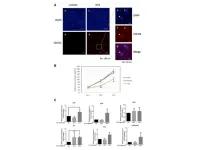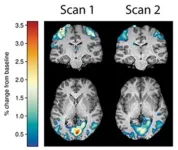New bottlenose dolphin sense discovered: they feel electricity
ottlenose dolphins’ electric sense could help them navigate the globe
2023-12-01
(Press-News.org) Born tail first, bottlenose dolphin calves emerge equipped with two slender rows of whiskers along their beak-like snouts – much like the touch-sensitive whiskers of seals. But the whiskers fall out soon after birth, leaving the youngster with a series of dimples, known as vibrissal pits. Recently Tim Hüttner and Guido Dehnhardt, from University of Rostock, Germany, began to suspect that the dimples may be more than just a relic. Could they allow adult bottlenose dolphins to sense weak electric fields? Taking an initial close look, they realised that the remnant pits resemble the structures that allow sharks to detect electric fields, and when they checked whether captive bottlenose dolphins could sense an electric field in water, all of the animals felt the field. ‘It was very impressive to see’, says Dehnhardt, who publishes the extraordinary discovery and how the animals could use their electric sense on 30 November 2023 in Journal of Experimental Biology on 30 November 2023.
To find out how sensitive bottlenose dolphins are to the electric fields produced by lifeforms in water Dehnhardt and Hüttner teamed up with Lorenzo von Fersen at Nuremberg Zoo and Lars Miersch at University of Rostock. First they tested the sensitivity of two bottlenose dolphins, Donna and Dolly, to different electric fields to find out whether the dolphins could detect a fish buried in the sandy sea floor. After training each animal to rest its jaw on a submerged metal bar, Hüttner, Armin Fritz (Nuremberg Zoo) and an army of colleagues taught the dolphins to swim away within 5 seconds of feeling an electric field produced by electrodes immediately above the dolphin’s snout. Gradually decreasing the electric field from 500 to 2μV/cm, the team kept track of how many times the dolphins departed on cue and were impressed; Donna and Dolly were equally sensitive to the strongest fields, exiting correctly almost every time. It was only when the electric fields became weaker that it became evident that Donna was slightly more sensitive, sensing fields that were 2.4μV/cm, while Dolly became aware of fields of 5.5μV/cm.
However, the electric fields produced by living animals aren’t just static. The pulsing movements of fish gills cause their electric fields to fluctuate, so could Donna and Dolly sense pulsing fields as well? This time the team pulsed the electric fields 1, 5 and 25 times per second while reducing the field strength, and sure enough, the dolphins could sense the fields. However, neither of the animals were as sensitive to the alternating fields as they were to the unvarying electric fields. Dolly could only pick up the slowest field at 28.9μV/cm, while Donna picked up all three of the oscillating fields, sensing the slowest at 11.7μV/cm.
So what does this new super sense mean for dolphins in practice? Dehnhardt says, ‘The sensitivity to weak electric fields helps a dolphin search for fish hidden in sediment over the last few centimetres before snapping them up’, in contrast to sharks, the electrosensitive superstars, which are capable of sensing the electric fields of fish within 30–70cm. Hüttner and Dehnhardt also suspect that the dolphin’s ability to feel electricity could help them on a larger scale. ‘This sensory ability can also be used to explain the orientation of toothed whales to the earth’s magnetic field’, says Dehnhardt, explaining that dolphins swimming through weak areas of the earth’s magnetic field at a normal speed of 10m/s could generate a detectable electric field of 2.5μV/cm across their body. And, if the animals swim faster, they are even more likely to sense the planet’s magnetic field, allowing them to use their electric sense to navigate the globe by magnetic map.
***************************
IF REPORTING THIS STORY, PLEASE MENTION JOURNAL OF EXPERIMENTAL BIOLOGY AS THE SOURCE AND, IF REPORTING ONLINE, PLEASE CARRY A LINK TO: https://journals.biologists.com/jeb/article-lookup/doi/10.1242/jeb.245845
REFERENCE: Hüttner, T., von Fersen, L., Miersch, L. and Dehnhardt, G. (2023). Passive electroreception in bottlenose dolphins (Tursiops truncatus): implication for micro- and large-scale orientation. J. Exp. Biol. 226, jeb245845. doi:10.1242/jeb.245845.
DOI:10.1242/jeb.246907
This article is posted on this site to give advance access to other authorised media who may wish to report on this story. Full attribution is required and if reporting online a link to https://journals.biologists.com/jeb is also required. The story posted here is COPYRIGHTED. Advance permission is required before any and every reproduction of each article in full from permissions@biologists.com.
THIS ARTICLE IS EMBARGOED UNTIL THURSDAY, 30 NOVEMBER 2023, 18:00 HRS EST (23:00 HRS GMT)
END
ELSE PRESS RELEASES FROM THIS DATE:
2023-11-30
BUFFALO, N.Y. — Possessing more than two complete sets of chromosomes can be a hindrance to long-term survival of a plant lineage, yet scientists are also finding evidence it’s likely behind some evolutionary innovation.
Sudden inheritance of whole suites of extra gene copies can add redundancy to an organism's regular sets of functions, actually permitting some of those copies to evolve and express in entirely new ways.
In the case of the East Asian pitcher plant, this mutational freedom may have even fine-turned its ability to capture prey and satisfy its appetite for “meat.”
That’s just one of the findings ...
2023-11-30
COLUMBUS, Ohio – For the first time, scientists have begun to figure out why the disfiguring skin lesions caused by cutaneous leishmaniasis don’t hurt.
Researchers analyzed leishmaniasis lesions on mouse skin to detect metabolic signaling pathways that differed from uninfected mice. Results suggested the parasites that cause the disease change pain perception – presumably as a way to delay treatment and promote their own survival.
“No one knows why these lesions are painless – ...
2023-11-30
“In this article, we describe for the first time the impact of chronological aging on EVs production by human keratinocytes.”
BUFFALO, NY- November 30, 2023 – A new research paper was published on the cover of Aging (listed by MEDLINE/PubMed as "Aging (Albany NY)" and "Aging-US" by Web of Science) Volume 15, Issue 22, entitled, “Chronological aging impacts abundance, function and microRNA content of extracellular vesicles produced by human epidermal keratinocytes.”
The disturbance of intercellular communication is one of the hallmarks of aging. In their new study, researchers ...
2023-11-30
As part of its ongoing quest to advance better brain health and performance, new research led by Center for BrainHealth at The University of Texas at Dallas investigated neural biomarkers associated with improvements on a brain health index.
The study, “Toward Precision Brain Health: Accurate Prediction of a Cognitive Index Trajectory Using Neuroimaging Metrics,” was recently published in Cerebral Cortex
A total of 48 participants aged 21–65 completed a simple task during a functional magnetic resonance imaging (fMRI) session, then once ...
2023-11-30
Researchers at UC Davis Comprehensive Cancer Center have shown that inhibiting a specific protein using gene therapy can shrink hepatocellular carcinoma (HCC) in mice. Silencing the galectin 1 (Gal1) protein, which is often over-expressed in HCC, also improved the anti-cancer immune response and increased the number of killer T cells inside tumors. The study was published in Acta Pharmaceutica Sinica B.
“We’ve long known that Gal1 is a biomarker for hepatocellular carcinoma,” said ...
2023-11-30
EL PASO, Texas (Nov. 30, 2023) – Space near earth is teeming with objects, whether natural, like meteors and comets, or manmade, like satellites, spacecraft and rocket debris. But experts still need a clearer picture of the location and state of these objects, which can threaten space-based assets, such as GPS, weather-monitoring and communication satellites.
“The United States is dependent economically and militarily on space assets,” said Miguel Velez-Reyes, Ph.D., chair of the Electrical and Computer Engineering Department at The University of Texas at El Paso. “For ...
2023-11-30
Research has shown that social media can negatively impact people's mental health. But can it affect people’s beliefs about mental health treatment?
Yes, according to researchers at Union. In one of the first studies to examine the impact of social media on people’s perceptions of mental health care, researchers discovered that viewing just a few social media posts that mock mental health treatment can have a profound impact on some people's attitudes toward treatment.
The study appears in the latest issue of the journal Social Media + Society.
For the study, 186 participants viewed 10 tweets. The gender ...
2023-11-30
New research from Northern Arizona University has explained coast redwood’s remarkable ability to recover from very severe fire, a rare sign of optimism amid a landscape increasingly scarred by severe fires.
The study, published today in Nature: Plants, examined recovery after the catastrophic CZU Lightning Complex Fire, which began in August 2020 and burned thousands of acres of redwoods in Big Basin State Park in California, some more than 1,500 years old. Researchers from NAU’s Center for Ecosystem Science and Society (Ecoss) and the School of Informatics, Computing, and Cyber Systems (SICCS) found, however, that many trees were not dead, as they first appeared. Redwoods ...
2023-11-30
The American Institute of Biological Sciences is pleased to announce Dr. Nyeema C. Harris as the 2023 winner of its Inspiring Inclusivity, Diversity, Equity, Acceptance, and Learning (IDEAL) Leadership Award. The IDEAL Award recognizes commendable leadership in advancing inclusion, diversity, equity, acceptance, accessibility, and learning in the biological sciences community. The award was presented by past awardee Dr. Steward T. A. Pickett on 30 November 2023 at AIBS's Council of Member Societies and Organizations meeting, entitled "Expanding the ...
2023-11-30
(Santa Barbara, Calif.) — Flames roared through Santa Barbara County in late 2017. UC Santa Barbara canceled classes, and the administration recommended donning an N95, long before the COVID pandemic made the mask a household item. Smoke and ash choked the air, but the Thomas Fire’s effects weren’t restricted to the land and sky. Huge amounts of ash settled into the oceans, leaving researchers to wonder what effect it might have on marine life.
Now scientists at UC Santa Barbara have discovered that wildfire ash adds nutrients to marine systems, ...
LAST 30 PRESS RELEASES:
[Press-News.org] New bottlenose dolphin sense discovered: they feel electricity
ottlenose dolphins’ electric sense could help them navigate the globe


